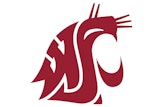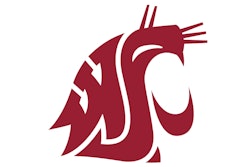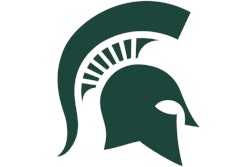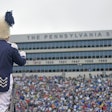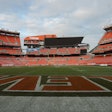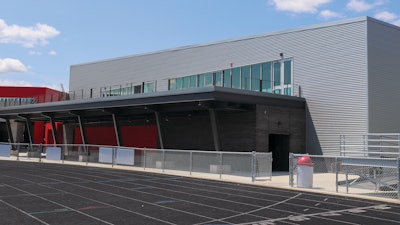

DCI is back at Middleton this year after completion of Phase 1 of the Cardinals’ $13 million stadium improvement project, which adds, among many other amenities, 30 new public toilet fixtures (one family, 11 men’s, and 18 women’s toilets).
“We’re super excited about that,” says superintendent Dana Monogue “I think there are 16 different sports and activities that will actively use the facility in addition to our regular physical education classes during the day.”
Indeed, the newly completed athletics complex will change everything for athletics at MHS — from keeping spectators and players safe and comfortable to simplifying game-day logistics. Here’s a look at how one community banded together to improve their facilities while keeping pace with their local rivals’ accommodations.

Money, money, money
Middleton began its mission for a new stadium complex when a group of alumnus approached the district with a plan to improve the school’s existing facilities. Those plans became a reality with a generous donation from alumni, including a particularly impactful gift from former Middleton football player Mike Borden.
“So the alumni group came to us, and they’re like, ‘Listen, let’s do something unique. Let’s not put it to a referendum. Let’s not put this on the backs of the taxpayers. We think that we have enough interest from the alumni community, and if the district is willing to pitch in, and if we fundraise together, we think we could do something pretty awesome,’ ” says Monogue. “Part of their initial ask included one very generous, very wealthy alum who was willing to write a check for a large portion of the entire project. It’s a $13 million project and Mike Borden, who is the alum, and his family, have contributed well over $7 million already toward it.”
The school district’s $2 million contribution to the project was savvily managed through the sale of residential lots in the area of an elementary school that were zoned solely for residential use and not connected to land that remains in the area and that could be used for a future third middle school, if needed.
The remaining fundraising to complete the second phase of the project, which includes an upper-level banquet and conference space, is ongoing. Among other initiatives, the school is now selling engraved brick pavers to raise funds. The bricks go for $500 for a 4-by-8-inch brick with three lines of text, or $1,000 for an 8-by-8-inch paver with up to six lines of text.
Monogue says the facility’s return on investment isn’t being seen just within the school but also in the community at large. “Some of the most excited people about this build are our chamber of commerce, because they know what the draw is going to be for our downtown area businesses, restaurants and hotels.”

More than just a football stadium
The new complex includes an enlarged concessions area, dedicated coaches and athletic trainer rooms, new locker and team rooms, restrooms, and new ticket booths for the stadium and baseball field. The project also includes the second-level meeting and banquet facility, which overlooks both fields and can be divided into classrooms.
Middleton administrators consistently stressed throughout the planning process that the stadium improvement project would offer all students, as well as community members, more opportunities. At a groundbreaking ceremony in May 2022, athletic director Jamie Sims noted that the project would not only provide for an improved student-athlete experience but would also allow the school to be more competitive at attracting local and outside programs.
“We have some different external partners.” explains Monogue. “Our police department, for example, uses that facility for some training programs. And then we have a lot of youth programs — a youth football program, youth soccer programming, a youth lacrosse program. They’re excited about using the new facility, as well.”
Aside from simply providing an improved experience for athletes and spectators, Middleton is part of Wisconsin’s competitive Big 8 Conference, and the modern era of high school athletics can sometimes closely resemble the collegiate level, with parents “shopping” schools for their kids.
“All the schools in Dane County are great,” says Monogue, “but oftentimes, when people want kind of a larger school feeling, they visit Verona, they visit Sun Prairie, and they visit us. And a couple of people have chosen us because of the stadium project and the commitment to extracurriculars that seems to be evident in our community. Everyone we’ve taken through has been, ‘Wow, this is a huge upgrade.’ ”

Game-day improvements
While the Borden Complex, as it’s been named, is meant to enhance the lives all students and community members, it also represents a huge upgrade for players, coaches and spectators on game day. From the parking lot, the facility’s modern exterior offers the existing Breitenbach Stadium an inviting face that locates everything needed for sporting events close to the field, while also securing the stadium’s perimeter with a single, easy-to-monitor point of entry.
Middleton didn’t completely neglect the stadium prior to the renovation. In 2000, the school added a unique double-decker press box, one of only three in the state. New bleachers were installed 10 years ago to increase the stadium’s capacity to roughly 5,000. And in 2007, the Cardinals upgraded to synthetic turf. But the cumulative impact of those incremental upgrades pales in comparison to what this most recent facility has accomplished.
Cardinals co-head football coach Tim Simon says he received his share of ribbing from rival coaches about the long trek from the locker rooms to the field prior to the recent upgrade. The new facility is now just steps from the field, which simplifies everything before, during and after a big game.
“Our opponents — some of them become coaching friends over the years — would give us a hard time because they’d have to walk miles,” says Simon. “So not to sound insensitive, but it’s overdue. It’s just the little logistical things we think about, and if we came out to our field, we forgot something, we kind of went into a panic mode, and now it’s right there. It’ll be nice.”
A tour through the facility reveals improvements at every turn, from expanded locker rooms with individual private shower stalls to the dedicated equipment drying room, which is fitted with an air-filtration and dehumidification system that eliminates odor and keeps bacteria-causing moisture at bay. Coaches’ areas include private lockers and showers and are equipped with Wi-Fi and monitors for reviewing game footage.
Another aspect of the new facility that was important to alum donor Borden was ADA access, which the previous stadium didn’t have. “If you were in a wheelchair, and you wanted to use the bathroom, we did nothing for you,” Simon acknowledges. “Mike Borden, who was one of the first kids I had in class — I mean, he’s the name on there, right? — he told a very touching story about his dad, who was a quadriplegic, and what it was like to get his dad ready for a home football game when [Mike] was playing here. So that’s a really important improvement.”
Aside from what’s already been completed, Phase 2 of the facility, for which there is still about $2 million to raise, literally and figuratively takes the project to another level. Simon envisions the second level of the facility as a versatile space with a view to boot. “Our end-of-year football banquet is hosted in there,” he says. “And if you want to start a gym class up there for 15 to 20 minutes and then you head out to the turf for your free movement, there’s just a lot of options.”
Essentially landlocked in a semi-urban area, the second-level addition was a way of getting the most of out of what real estate was available for the project. “There’s an outdoor veranda on both the football side and the baseball side, so people can watch the games from there,” Monogue says. “I think the architect and the construction company were really savvy in looking at the small land space that we had, and they really made the most of it.”

Collaboration and appreciation
With Middleton’s first home game scheduled for the second week of September, the school will host family night at the new facility Aug. 4 to give students and the community a chance to view the new digs and feel a sense of ownership in the facility.
“We’re going to practice from 7 to 9, but it’s open to the public,” says Simon. “We just want to welcome the community to take a look at our facilities and come watch the team practice and play.”
Co-head coach Joe Poehls says he couldn’t be more grateful for the facility, noting the collaborative effort it took to bring the project to fruition. “As somebody who coaches here, we’re so appreciative,” Poehls says. “A lot of community members have come together, and a lot of people from Middleton’s history just kind of came together and are excited about it and want to see our school and the community succeed. It’s just awesome.”















